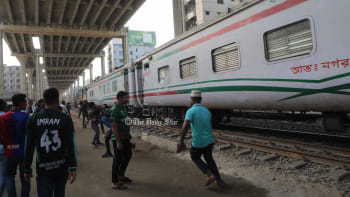Promise of a healthier, more equitable SE Asia

The promise of universal health coverage (UHC) is bold: that all people can access quality health services, when and where they need them, without suffering financial hardship.
UHC's benefits are clear. UHC is central to improving health and well-being—a fundamental human right. Healthier populations in turn create more productive economies that raise living standards. UHC also strengthens health security by making it easier to contain the spread of infectious disease and respond effectively to natural disasters. UHC's potential to promote better health, enhance equity and fortify health security can—and must—be fully harnessed.
Importantly, UHC is feasible: Whether a country is rich or poor, progress is possible. Some countries, including in the WHO South-East Asia region, have already made significant advances. They began doing so when they were "low-income". That is a critical point. No-one starts from zero; there are always opportunities to move ahead.
Since 2014 WHO South-East Asia has worked to leverage those opportunities, identifying UHC as a Flagship Priority, and—in consultation with member countries—mapping-out and implementing a series of game-changing initiatives.
That includes increasing the availability and performance of health workers and ensuring their knowledge and skills are fit-for-purpose for today's (and tomorrow's) health needs. It also includes attracting health workers to rural and hard-to-reach areas and retaining them once there. Adapting frontline services to meet the needs of the region's ageing populations, as well as the growing burden of noncommunicable diseases (NCDs) such as diabetes and heart disease, has likewise been a crucial point of focus. That can be well understood. Apart from the region-wide shift to increasingly sedentary lifestyles, by 2020 more of the region's population will be over 60 than under five.
Increasing access to essential medicines has been similarly fundamental. Innovative mechanisms such as the South-East Asia Regulatory Network, which pools the region's regulatory resources, will go a long way to helping make safe, good quality medicines and medical products accessible to all. So too will present efforts to encourage greater price transparency via a multi-country information-sharing platform. A region-wide initiative to pool the procurement of medicines, beginning with antidotes, will meanwhile benefit its smaller countries by increasing their bargaining power.
In each of these areas and more, progress has been made. According to the latest data, in the last eight years health services coverage has improved in all of the region's 11 member countries. That is to be celebrated.
But region-wide challenges remain immense. Around half of the South-East Asia region's population still lacks full coverage of essential health services. Some 65 million are pushed into extreme poverty, mainly due to paying out-of-pocket for medicines, especially for NCDs and other common ailments.
Given the region's sustained economic growth, accelerated progress is both possible and necessary. Though action across sectors is essential to enhance health coverage, priority health programmes clearly play a major role. But to make health services truly universal they must be designed around and for people, rather than around diseases or institutions. Doing so will have immediate and lasting impact.
Accordingly, increased public spending on health is crucial. Increased public spending not only makes additional resources available—from more staff to basic tools and technologies—but can also help reduce household out-of-pocket spending, thereby increasing financial protection. In recent years, many of the region's countries have increased the amount they spend on health. This should also increase the affordability of (and therefore access to) health services, while decreasing the number of people being left behind.
But more public funding is not enough. Greater value for money is imperative. That means developing and implementing long-term strategies that define what services are required, who will deliver them, and designing payment mechanisms that maximise efficiency and equity. Sound complex? Basically, it means organising health systems in ways that offer the right services to the people who need them.
Finally, monitoring matters. Monitoring helps us understand who is being left behind and why. It helps us learn what is working and what is not, allowing us to make course corrections where needed. It is to the region's immense credit that in 2017 eight member countries completed voluntary national reviews of progress on the Sustainable Development Goals (SDG), including on health. In the same year, member countries unanimously agreed to review progress on UHC and SDG3 (the health-specific goal) at WHO South-East Asia's annual Regional Committee until 2030. That will prove critical to gauging progress and maintaining momentum.
To that end, the wind is at our back. The leadership and vision of WHO Director General Dr Tedros Adhanom Ghebreyesus—whose top priority is securing health coverage for all—is driving global support for what WHO South-East Asia and its member countries are striving to achieve. To honor a promise that is bold yet simple, and that will change the lives of millions of people across the region and beyond—health coverage that is universal, health coverage that is for everyone, everywhere and leaves no one behind.
Dr Poonam Khetrapal Singh, WHO South-East Asia Regional Director.






Comments